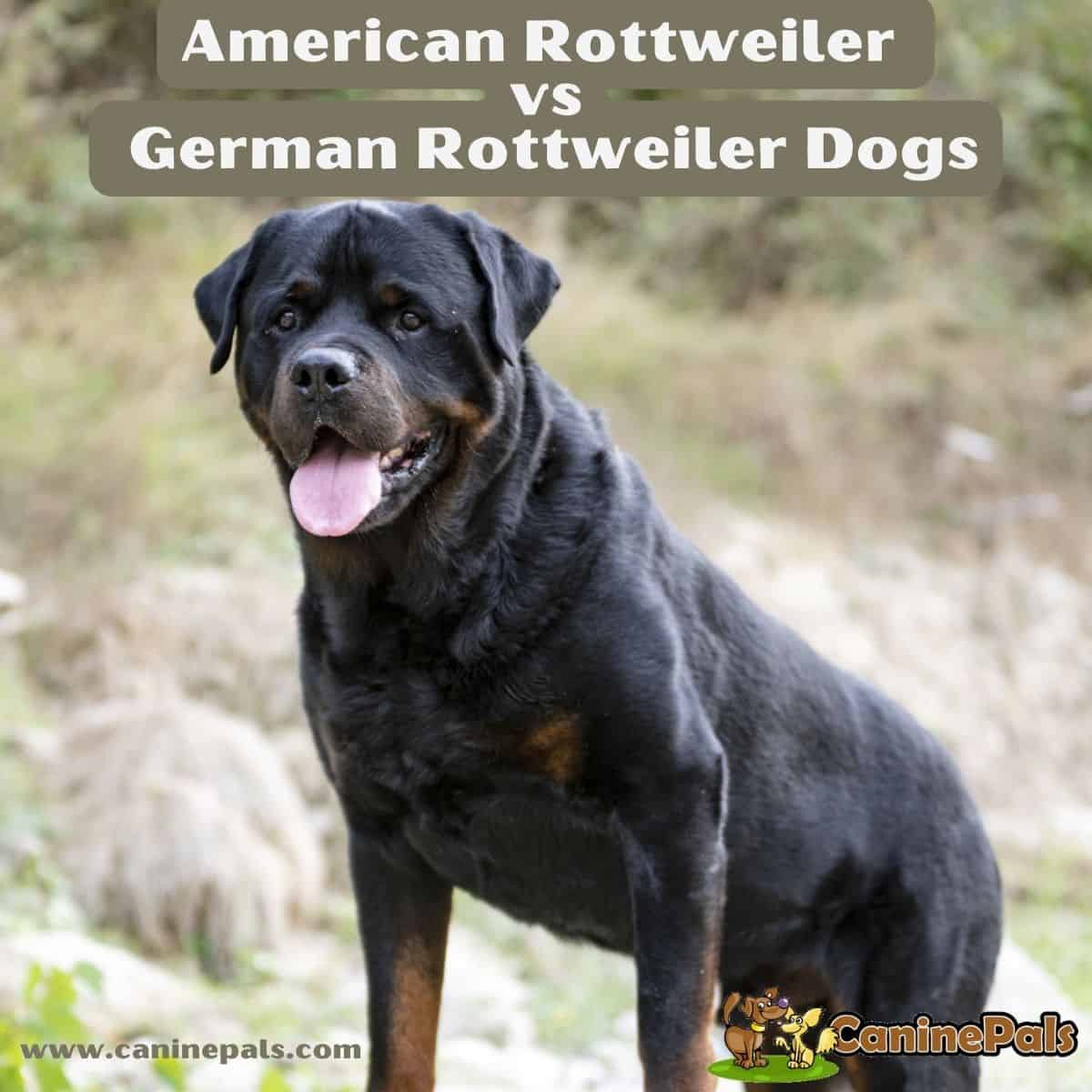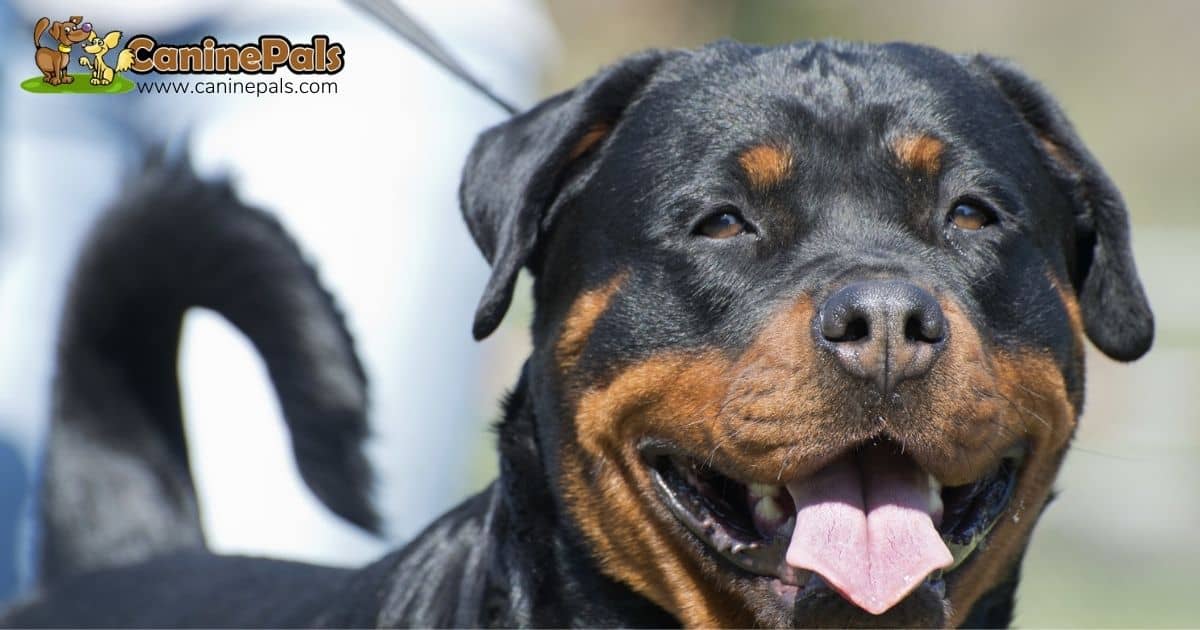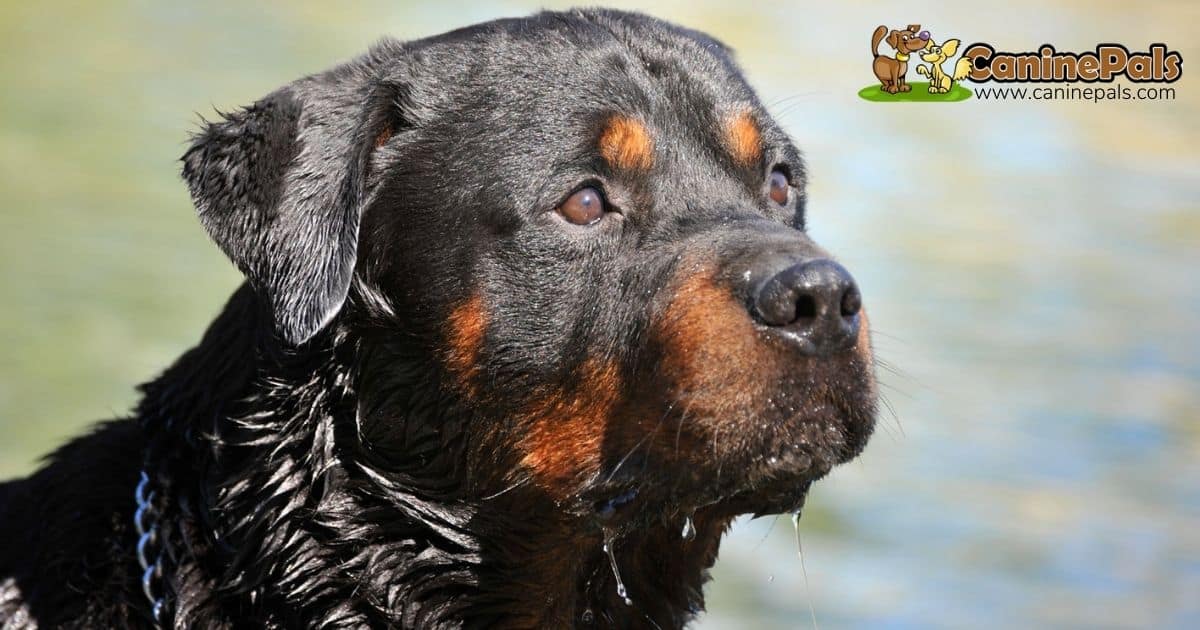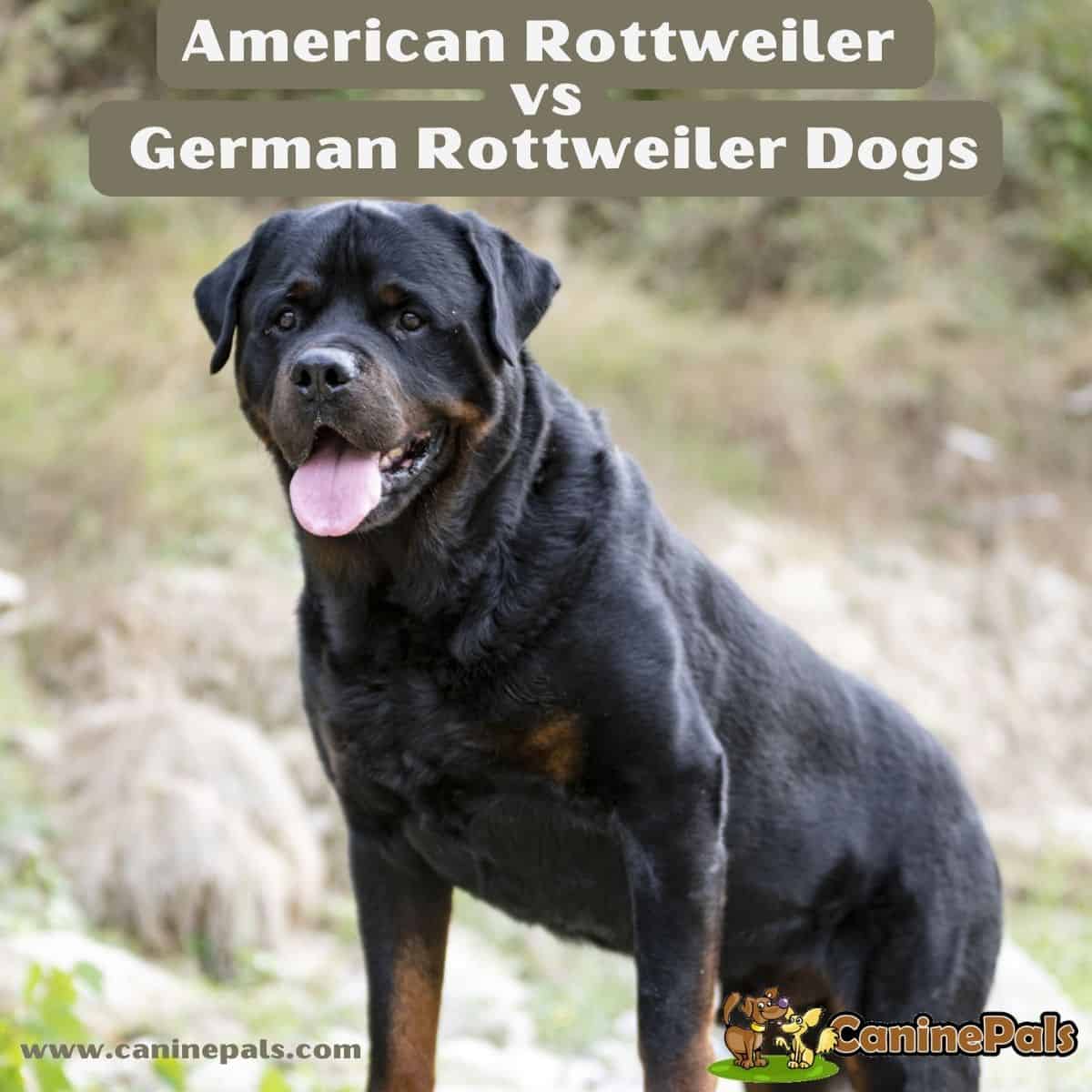Last Updated on March 20, 2024 by Denise Leo. Post first published on November 4, 2022.
The black and mahogany coat, wide head, broader body, alert ears, and dark-brown almond eyes; none can have these intimidating appearance traits other than a Rottweiler! When you see them, you instantly know it’s a Rottie.
The first question that pops up in your head is if this is an American Rottweiler or a German Rottweiler. Well, this is what we are about to discuss: German vs. American Rottweiler.
The article provides insights into the deal between a German Rottie and an American Rottie or if there is a difference between them at all.
Origin of Rottweilers
Rottweilers are deemed to be one of the oldest dog breeds. Their origin dates back to Roman times. The Romans used them for their protection and driving their cattle. Rottweilers then marched with the Roman legions over the Alps.
The Rottweiler originally followed the Romans and their herds when they invaded Europe. His guarding and controlling instinct was noticed by the Germans and bred for these traits. As these needs were reduced, he almost became extinct. In the early 1900s, his breed was formally acknowledged.
In Rottweil, the Rottweilers mixed in a natural crossing with the native dogs. In fact, Rottweil is the city where their name comes from. The Rottweilers served great purposes during both World War I and the Second World War. They were used as police dogs, guard dogs, and for driving purposes.
Various Rottweiler clubs were founded in Germany from 1914 onwards. These clubs then merged later in 1921 to form ADRK (Allgemeiner Deutscher Rottweiler-Klub), the General German Rottweiler Club. The ADRK has worldwide recognition for being the home club of Rottweilers.
The American Kennel Club (AKC) recognized the Rottweilers in 1931. During the mid-’90s, the most recognized dog breed by AKC was Rottweilers. Rotties stood among the top 10 most popular breeds by the AKC in 2017.
American Rottweiler vs. German Rottweiler Dogs Difference
If your Rottweiler loves apple pie and appreciates the taste of vanilla ice cream, chances are he’s American, and if your Rottie boasts thick bones and barks in a German accent, his bloodlines come from Germany!
Well, jokes apart;
The truth is, if we talk about American Rottweiler vs. German Rottweiler dogs, the only difference that exists between them is their place of birth. American Rottweilers are the ones bred in America, while German Rottweilers are bred in Germany. That’s it!

In fact, the Fédération Cynologique Internationale (FCI), the world’s largest canine organization, does not use the territorial prefix like American and German with Rottweilers at all.
However, there may still exist some slight appearance differences between the two. The standards set by the AKC (American Kennel Club) and the ADRK (Allgemeiner Deutscher Rottweiler-Klub) also help to distinguish between the German vs. American Rottweiler puppies.
ADRK Standards for Rottweiler
The ADRK has some strict rulings to register Rottweilers. They have a set of standards, and if any Rottweiler pup fails to meet those standards and does not pass the Breeding Suitability Test, it is not considered a true German Rottweiler.
The Suitability Test checks the dog for specific areas. Those areas include:
- Head (eyes)
- Snout (tongue and teeth)
- Shoulder
- Dewlap
- Elbow
- Forefeet and hind feet
- The highest point of the rump
- Hock
- Legs (thighs and hips)
- Stifle
- Withers
- Paws
- Tail
A Rottweiler or its subsequent puppies will not qualify for registration if any flaws are found in the areas mentioned above. The only goal of the ADRK is to produce a better breed, and since tail-docking and ear-cropping are banned in Germany, the Rottweilers having these flaws are disqualified too. The ADRK also requires the Rottweiler parents to have a certificate that refers to potential genetic defects or diseases.
AKC Standards for Rottweilers
AKC follows somewhat the same standards as that of ADRK to register a Rottweiler. The Rottweilers are tested and checked for the areas listed above. And any flaw in either appearance or temperament will lead to the disqualification of registration of Rottweiler.
However, registering a Rottweiler in the US is still easier than registering a Rottweiler in Germany. ADRK follows highly strict standards to test a Rottweiler to produce a pure and true breed.
This allows many profit-seeking breeders in the US to breed a Rottweiler that is deviated from the original breed. This is certainly not true for all breeders. The purpose of providing the information is to make you aware of deceit.
Quick Rottweiler Information Facts
- He’s a powerful, robust dog with great endurance and intellect and a willingness to work hard.
- He works well as a herder, police dog, service dog, competitor in obedience trials, and therapy dog.
- He’s also a great companion. He has a clownish manner towards his family and friends but is very territorial when it comes to strangers coming into his home unless he’s introduced properly.
- He must be allowed to mix with people and taught obedience.
- He needs regular exercise but only minimal grooming.
- His coat is black and has mahogany to rust markings. He stands 22 – 27 inches in height.
Appearance of Rottweilers
The Fédération Cynologique Internationale (FCI) provides a description standard for how a Rottweiler should look without using the regional prefix like German or American.
They individually describe each appearance trait in detail.
- Head: The head of the Rottweiler is medium-sized in length and broad between the ears. When seen from the side, their forehead appears to look arched.
Their nose is broad and round, and they have large nostrils. The color of their nose is always black.
Their black and closely-fitted lips are invisible. The gums are dark too (should be black), with strong and broad lower and upper jaws.
Their eyes are almond-shaped, medium-sized, and dark brown in color with close-fitted eyelids.
Their ears are alert, triangular-shaped, placed high on their head, and wide apart. They have tight-fitted skin on their head. - Neck: Without excessive dewlap, their neck is free from throatiness. It appears strong and well-muscled with adequate length and a slight arch.
- Body: Rottweilers have a strong bodies. Their deep chest is broad with well-sprung ribs.
- Tail: Here lies the major American rottweiler vs. German rottweiler difference. Germany has banned the practice of tail-docking, while in the US, the practice is still prevalent, and the Rottweilers with a docked tail are preferred. The FCI (Fédération Cynologique Internationale) follows the Country of Origin Breed Standard for tail description.
- Limbs: The front and rear legs are not placed too close to each other. The shoulders are strong and laid back well. The front feet and toes are strong, well-arched, and tight with strong and short black nails.
- Gait: If a Rottweiler trots, that’s fine. Trotting comes naturally to them. But if the Rottie is sluggish while trotting, that is deemed a severe fault. Their movements are steady, unrestricted, and energetic, and they have a fine pace. Their balance and effectiveness are harmonious.
- Coat: They have an outer coat and an undercoat. Their undercoat is not visible through the outer coat and is present on the thighs and neck. Rottweilers belonging to hotter regions may not have the undercoat. Their outer coat is medium-length, dense, coarse, and flat. They are easy to maintain, but they do experience seasonal shedding. AKC considers long and wavy coats as faulty. According to AKC’s standards, the coat of Rottweilers is short and straight.
- Colors and Markings: Rotties are distinctive when it comes to colors and markings. The FCI standards describe them as black with rich tan markings on their cheeks, muzzle, over both eyes, throat, chest, legs, and under the base of the tail.
The AKC also counts rust or mahogany-colored markings that are not on more than 10 percent of the Rottie’s body. The AKC also specifies a dot above each eye on the inner brow ridge, on the cheeks, and on each side of the snout.

American Rottweiler vs. German Rottweiler Difference (Physical Appearance)
If you make the American and German Rottweiler stand side by side, you’ll notice that the American Rotties are more tall and spindly than the Germans. The American Rottweilers are known for their strength and endurance, and they are medium-large in size.
These are powerful canines and are considered working dogs. German Rottweilers are more striking and look intimidating with their broader and more muscular bodies. Their thick bones and blocky heads make them look impressive.
The head of American Rottweilers is relatively smaller than that of the German Rotties. The major difference between the two that instantly distinguishes them is a docked tail. Since tail-docking is prohibited in Germany, the German Rots are never bred with a docked tail, while the AKC appreciates a docked tail.
Another trait that distinguishes them is their size. The comprehensive differences are discussed further.
German Rottweiler vs. American Rottweiler Size
When it comes to size analysis of German vs. American Rottweilers puppies, both AKC and ADRK have their set of standards. They come in all sizes, i.e., small, medium, and large. The male dogs are relatively bigger than the female dogs.
AKC Standards for Size
The AKC has provided a general size of the Rottweilers for both male and female dogs. Their standards are:
| Male American Rotties | Female American Rotties | |
| Height | 24 to 27 inches | 22 to 25 inches |
| Weight | 95 to 135 pounds | 80 to 100 pounds |

ADRK Standards
ADRK standards are incredible when it comes to Rottweiler sizes. They have split their size as small, medium, large, and very large. Since their aim is to produce perfect Rotties, they provide their breeders with well-guided information.
| Male German Rotties | Female German Rotties | |
| Height | 24 to 27 inches
Small: 24 inches Medium: 25 inches Large: 26 inches Very Large: 27 inches |
22 to 25 inches
Small: 22 inches Medium: 23 inches Large: 24 inches Very Large: 25 inches |
| Weight | 110 pounds approx. | 93 pounds approx. |
German Rottweiler vs. American Rottweiler Temperament
Although their temperament greatly depends on how they were raised and socialized by the breeders and owners, in general, they have a placid attitude. Besides, while registering the Rotties, they are tested for their temperament as well. The more their temperament deviates from their natural temperament, the more is a chance they won’t get registered.
| American Rottweilers | German Rottweilers | |
| Trainability | In short, these dogs are intelligent and easy to train. They love to please their master. But they do show signs of aggression and stubbornness if treated roughly. | German Rotties are obedient. They pick up the commands and learn them quickly. If given treats, they can respond even better. They are taught to track and protect too. |
| With Children | As compared to other dog breeds, American Rottweilers get along well with kids. | German Rottweilers are good with kids, just like American Rottweilers. But adult supervision is always appreciated no matter whatever dog you have. |
| With Strangers | Since Rottweilers are guard dogs, they get alert seeing a stranger. | German Rotties are no different than American Rotties when it comes to getting along with strangers. They won’t show signs of aggressiveness; rather, they’ll get alert. |
| With Other Pets | Dog-on-dog dominance can never be neglected with Rottweilers. They can get along with other pets, especially if raised with them, but seeing a dog of the same gender may make them react violently. | With sharp personalities and dominance in their nature, German Rotties show disliking towards dogs of the same gender. They may accept other pets, though. |
What Happens to Rottweilers When Breeding Standards are Lowered
If breeding standards are lowered, the dogs may deviate from their natural physical appearance over time. Their temperament is also highly affected, and health issues may arise as well.
- A visible change in their wide head occurs. It becomes narrow, and their short muzzle becomes elongated.
- Their muscular structure rather changes to less compact and leggy.
- The markings on their fur fade.
- Their eyes turn to pale from the dark brown.
- Their gums become pink from black.
- Their temperament shows signs of aggression, and their behavior gets destructive.
The only thing that distinguishes an American Rotties bloodline from the German Rotties is the lower standards of breeding. If the American Rotties are bred as per the strict standards of Germans, there won’t be much difference between them.
Who is to Blame for the Distinction Between German Rottweilers and American Rottweilers?
There are some people and organizations responsible for the categorization of the breed. In order to preserve the breed, they set up their own standards and deviated from the originality of the Rottweilers. Some of the people to be held responsible are:
● Dog Clubs:
Many kennel clubs tailor their own standards to breed the dog. This has resulted in extreme variation and deviation.
● Dog Shows:
Sometimes, the judges of the dog shows might be learning the ropes of the breed specification. Without having comprehensive knowledge, they may sometimes incline towards a trait that is not associated with the breed. That results in breeders working on transforming the dogs.
● Breeders:
Dog breeders play an important role in transforming the dogs and deviating them for their profits. They work on changing the breed’s characteristics and temperament for their personal gains.
● Dog Owners:
Yes, dog owners are not excluded from the list of people who are supposed to be blamed. The reason is their own demands for a dog to be bred in a respective manner because they think it’s cool.
Which One is Good for You?
Whether American Rottweiler or German Rottweiler, they both need proper training, socializing, and physical and mental stimulation. They can be robust players if not trained well.
If you think you cannot manage time to train your pups, or you’re too lazy to do that, a rottweiler is not recommended for you. But if you think your Rottweiler won’t get neglected in your daily chores, they are the perfect family companions because of their lively yet placid temperament.
Besides, they may develop severe separation anxiety. If you stay too much outside the home, then as well, a Rottweiler isn’t for you.
Price Difference Between the American and German Rottweiler
The price of the Rottweilers depends on their breeding—the more rigorously bred, the more the piece. The breeders conforming to AKRD standards offer puppies at a higher price, while the breeders registering their pups with the AKC have a relatively lower price.

To give an estimate, a Rottweiler puppy can cost anywhere between $500 to $4000. The less you pay initially, the more you’ll have to pay later for their training as well as to deal with their health issues. When a puppy is cheap, the chances are that sub-standard methods were used for breeding them that may cause health problems in the future.

German Vs. American Rottweiler Conclusion:
To sum up the discussion of German vs. American Rottweiler dogs, there isn’t much difference between them other than the fact that the German Rotties are bred in Germany while the American Rotties are bred in America.
Unless you have imported your Rottie directly from Germany, your Rottweiler isn’t German. The American-bred Rottweiler (even though their parents were imported from Germany) are American with German bloodlines.
Whichever Rottie you have, if it is purebred, we are pretty sure you are in for a great time of your life. With an affectionate, loyal, obedient, mild, calm, trainable, yet fearless temperament, get ready to get your socks knocked off!
Copyright CaninePals.Com. All Rights Reserved.
References and Further Reading:
[1] American Kennel Club, Rottweiler Information.


